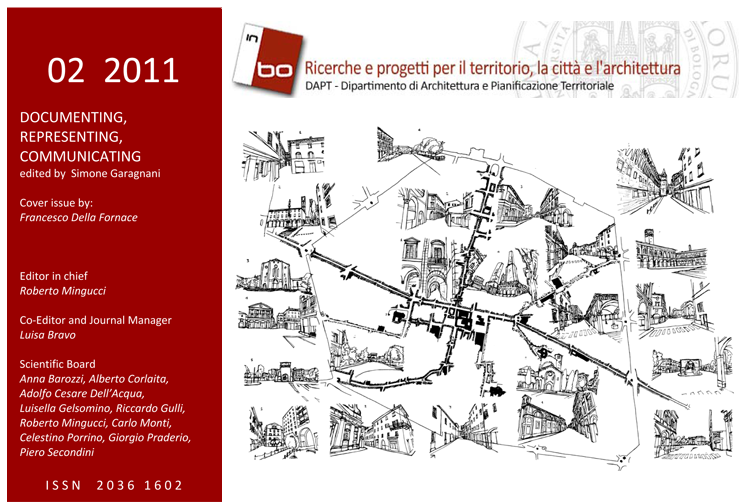Rediscovering stereoscopy to represent the architectural space
DOI:
https://doi.org/10.6092/issn.2036-1602/2356Keywords:
stereoscopy, digital representation, architectural drawing,Abstract
The steady development of graphic representation’s methods has been possible due to tools and techniques mostly belonging to their time: theevolution of the architecture “story telling” is still in progress, establishing the foundation of every project information and communication strategy.
The pervasive information processing operated by computers, through graphical and textual digital contents, led to a rediscovery of traditional approaches to depict the built space, declining them to new technologies in order to amplify their possibilities and values.
This happened to stereoscopy, common method adopted in photography since the 19th century to render the spatial perception through the binocular vision and today easily consistent with threedimensional models and digital images captured by special cameras.
This paper aims to investigate the features, benefits and criticality of stereoscopic immersive communication in the modern architecture of the project.
References
WHEATSTONE, Charles. 1838. On some remarkable, and hitherto unobserved, phenomenon of binocular vision. Philosophical Transactions of the Royal Society of London 128. London.
CANEVA, Giacomo, 1855. Della fotografia, trattato pratico di Giacomo Caneva pittore prospettico. Roma.
VALYUS, Nikolai. 1966. Stereoscopy. Focal Press. London.
FRASCARI, Marco. 1991. Monsters of architecture - Anthropomorphism in architectural theory. Rowman and Littlefield Publishers, Inc. Lanham, Maryland.
FONDELLI, Mario. 1992. Trattato di Fotogrammetria urbana e architettonica. Ed. Laterza. Roma.
MAFFIOLI, Monica, 1999. La stereoscopia nella produzione degli stabilimenti fotografici dei Fratelli Alinari e di Giacomo Brogi. AFT, Rivista di storia e fotografia (30):36-41
MIGLIARI Riccardo. 2001. Frontiere del Rilievo, dalla matita alle scansioni 3D. Gangemi Editore. Roma.
SCHARSTEIN, Daniel e SZELISKI, Richard. 2002. A Taxonomy and Evaluation of Dense Two-Frame Stereo Correspondence Algorithms. IJCV 47(1/2/3), pp. 7-42.
JASMANN, Schawn e ANDONIAN, Greg. 2003. Architecture and the Stereoscopic Space of Experience. Proceedings of the 7th Iberoamerican Congress of Digital Graphics SIGraDi. Rosario. Argentina.
ROBERTS, David. 2003. History of Lenticular and Related Autostereoscopic Methods. Leap Technologies. Hillsboro. pp. 16.
FAUSTER, Loris. 2007. Stereoscopic techniques in computer graphics. TU Wien.
REMONDINO, Fabio, EL-HAKIM, Sabry F., ZHANG, Li e GRUEN, Armin. 2008. Turning images into 3-D models. IEEE Signal Processing Magazine, Vol. 25, No. 4, pp. 55-64.
MILLODOT, Michel. 2009. Dictionary of Optometry and Visual Science. 7th edition. Butterworth-Heinemann. Oxford.
MANFERDINI, Anna Maria e GARAGNANI, Simone. 2011. Digital exhibition and fruition of archaeological finds. Proceedings of 4th International Workshop 3D-ARCH 2011 “3D Virtual Reconstruction and Visualization of Complex Architectures”. Trento.
Downloads
Published
How to Cite
Issue
Section
License
Copyright (c) 2011 Simone Garagnani
Copyrights and publishing rights of all the texts on this journal belong to the respective authors without restrictions.
This journal is licensed under a Creative Commons Attribution-NonCommercial 4.0 International License (full legal code).
See also our Open Access Policy.
Metadata
All the metadata of the published material is released in the public domain and may be used by anyone free of charge. This includes references.
Metadata — including references — may be re-used in any medium without prior permission for both not-for-profit and for-profit purposes. We kindly ask users to provide a link to the original metadata record.







